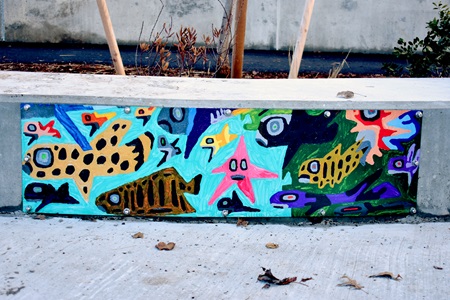Paintings By Artist With Autism Brighten Cambridge’s Universal Design Playground
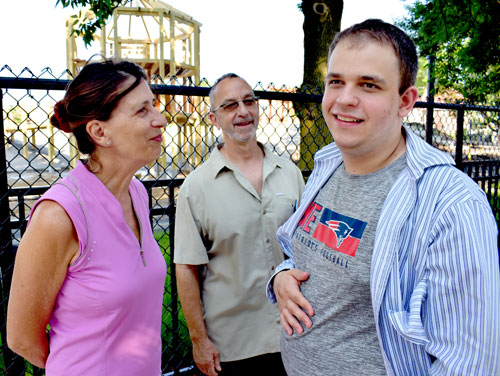 Dominic Killiany (right) with his parents Susan Cicconi (left) and Michael Killiany at the Louis A. DePasquale Universal Design Playground at Danehy Park, Cambridge, August 2021.
Dominic Killiany (right) with his parents Susan Cicconi (left) and Michael Killiany at the Louis A. DePasquale Universal Design Playground at Danehy Park, Cambridge, August 2021.
Climbing one of the play structures or otherwise exploring the Louis A. DePasquale Universal Design Playground at Danehy Park, you’ll spot pictures by Dominic Killiany, a prolific 24-year-old artist living with autism. Panels throughout the park reproduce his brightly colored paintings of Boston’s Zakim Bridge, street signs, fish, a lion, zebra, elephant and giraffes.
“The energy, the symbols, the patterns, the numbers, the alphabet all combine as visual stimulation for kids to follow through the park,” his mother, Susan Cicconi, says.
All are invited to attend a Dedication Ceremony for the playground at 75 Field St. on Saturday, April 30, 2022, at 11 a.m. (rain date: May 1 at 11 a.m.). Refreshments will be served. Admission is free. Located between Field Street and the Briston Arms residential complex, the 30,000 square foot play area is the first developed by the City of Cambridge to fully incorporate Universal Design—a concept that all the playground features should be as welcoming to and as usable as possible by people of all abilities.
The park offers swings, a climbing slope, and slides. There are also three public art commissions overseen by Cambridge Arts:
• The “Sensory Hilltop,” a pergola, benches and marimba created by Cambridge artist Mitch Ryerson.
• “Pipe Dreams,” a wooden play tunnel designed by students at Central Square’s NuVu Studio.
• Nine reproductions of Killiany’s paintings (with two more coming), funded in part through the City’s Percent-for-Art ordinance, which requires that 1 percent of construction costs on municipal capital investment be designated for creating public artwork.
“I’ve never seen a playground like this in my life. I’ve never seen a playground that checks all the boxes—visual stimulation, sensory stimulation, ramps, paths,” Cicconi says. “There’s a place where you can play music, so there’s sound. There’s touch. There’s visual. I’ve never seen anything like it.”
Being commissioned for a park crafted to be widely accessible through universal design is special to Killiany’s family because it provides opportunities to others, as Cicconi puts it, “in the club of living with autism” and families with special needs. She says, “You need support when you have a child with autism, so you need to reach out and help.”
Killiany has been drawing since he was little. “He’s mostly nonverbal, however he has language, he is articulate, he understands everything. The problem is expressing,” Cicconi says. “…The thing that caught our attention at age 3 was his ability to reproduce street signs in chalk on our driveway. To perfection.”
At age 14, “he took an interest in painting-by-numbers,” Cicconi says. “If you think of paint-by-numbers, the diagrams look like little puzzle pieces. … He focused mainly on how to make shapes to form a composition.” The following year, “he was making his own compositions.”
“I think he puts everything together like a puzzle or paint-by-numbers” his father, Michael Killiany, says.
Killiany painted landscapes, then animals. He reinterprets photos as line drawings in pencil, then fills each shape in with paint. At times, he numbered his own sketches like paint-by-number diagrams before painting them. Then he numbered all the spaces in sequence. “There was a period of a year, maybe two, where he had to number all the spaces,” Cicconi says. “It’s this sequencing thing he does. The numbers act as symbols, maybe they have meaning to him.” He’s partial to twos and twenty-twos and thirty-threes.
“He wants 10 tubes of paint for one canvas,” Cicconi says. If allowed, he prefers to squeeze out entire tubes to use in a single painting, painting it on thick, mixing colors until he gets his favorite yellows and whites and oranges—“cantaloupe orange, sweet potato orange, mandarin orange, or apricot orange.”
These days, Killiany’s favorite subjects are wild animals (lions, tigers, leopards, koalas, lionfish), cityscapes (Zaikim Bridge, Longfellow Bridge and Hancock Tower, Statue of Liberty), clocks, numbers, geometry, and shapes interlocked like puzzles. Killiany would only paint lions or tigers, Cicconi says, if she didn’t nudge him to try, say, the Zaikim Bridge—a landmark on the way home from his weekly drives with his father. Killiany and his mother search the internet for images until one catches his eye.
“The inspiration is key,” Michael Killiany says.
“I’ve tried to ask him why he likes those animals. He can’t respond to that question,” Cicconi says. “I just think that in another life he was a lion or tiger.”
Killiany has been living in a group home in Watertown since summer 2020 and lately painting at Turtle Studios in Newton.
“Covid hit him really hard and he stopped painting for 2021. He’s back now, he’s painting,” Cicconi says. “We found a fantastic studio space for him to paint.” He’ll often paint for eight hours at a stretch. “Art is therapy for Dominic. It’s when he’s most focused, most happy.”
Killiany was a 2021 finalist in the VSA (Very Special Arts) Emerging Young Artists Program, which includes his painting being exhibited at the U.S. Capitol in Washington, D.C., and in a traveling exhibition. He’s also scheduled to have artwork in “A World of Color” exhibition at Till Wave Art Gallery in Watertown from April 14 to June 2. Cicconi says sales of Killiany’s artworks help pay to keep some 150 paintings in storage—and hopefully will increase to become an income for him.
“Every kid with autism has a strength,” Cicconi says, “you just have to find it.”
-
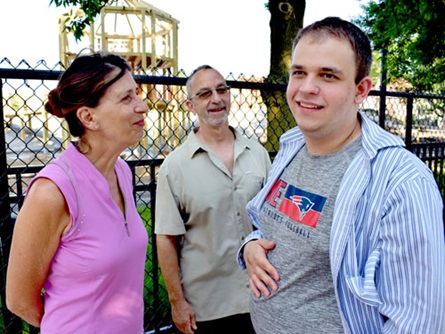
Download Full Resolution Image
Dominic Killiany (right) with his parents Susan Cicconi (left) and Michael Killiany at Louis A. DePasquale Universal Design Playground at Danehy Park, Cambridge, August 2021.
-
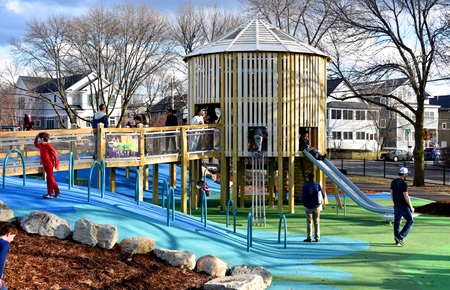
-
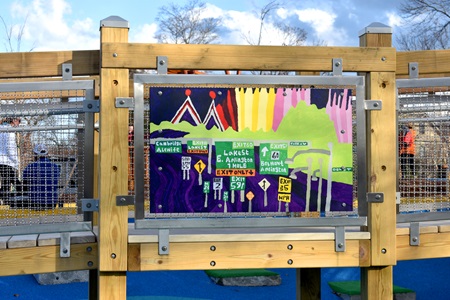
-
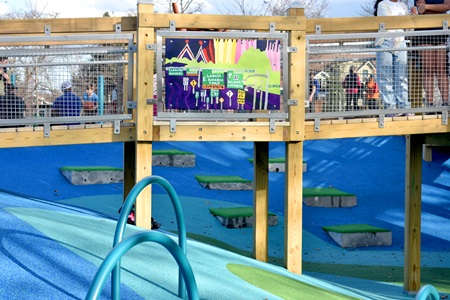
-
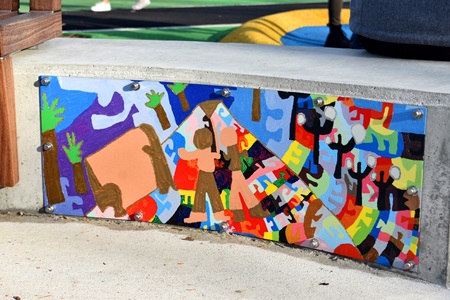
-
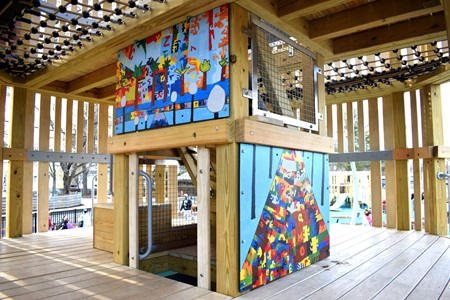
-
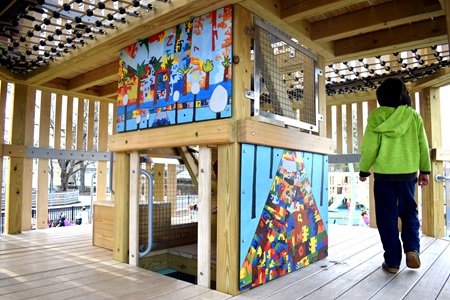
-
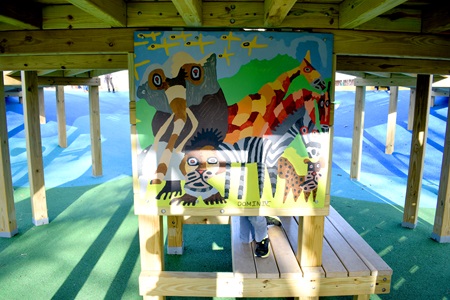
-
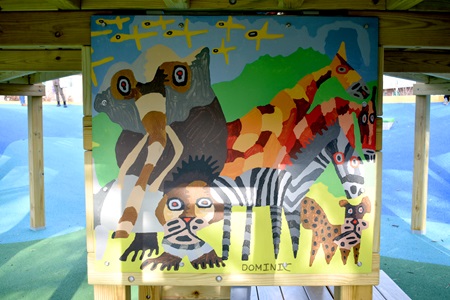
-
